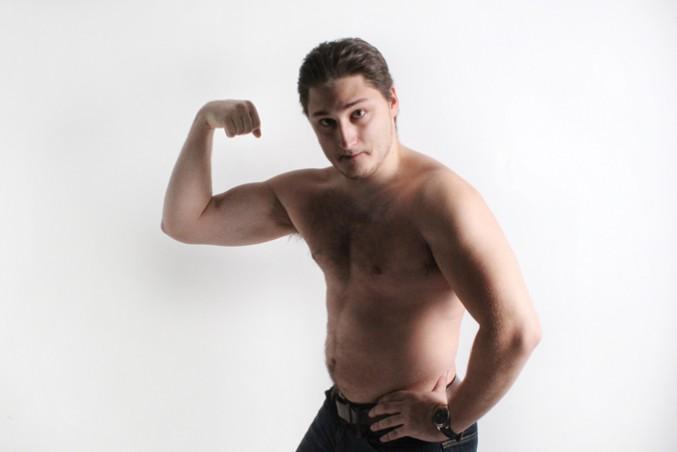By Jacob Dubé
I was standing on a snowy mountaintop, 1,300 feet above sea level. Peering down onto the steep, bumpy hill that dropped inches from the tip of my yellow skis, I knew there was no way I could do it.
My group was eager to take off. “Come on, be a man,” said one of them, hopping with anticipation in his oversized grey coat.
At that moment, I felt scared. Not of the death trap that lay under me, but of seeming inadequate to these people I barely knew. If I wasn’t a man, then what was I?
I took the plunge. They found me in a ditch 20 metres down.
“Be a man.”
Masculinity is broadly defined as a set of roles and behaviours generally associated with men. Some of these traits are often related to aggression, dominance and pride — but the idea of masculinity varies from person to person.
“I think it’s something that is very self-defined. It manifests in an infinite amount of ways. Masculinity, inherently, can be a cool, beautiful thing. It’s a part of everyone’s behaviours,” says Jackie Mlotek, a Ryerson social work student and co-founder of the Ryerson Feminist Collective.
Traditionally, the figurehead of the man was characterized in the framework of the nuclear family — an authoritative breadwinner who provides for and protects their family.
“It’s framed generally as something every man should strive to be, but it’s society framing it, not so much on an individual level,” says Alyson Rogers, who is also a Ryerson social work student and co-founder of the Ryerson Feminist Collective.
According to Ben Barry, associate professor of equity, diversity and inclusion at Ryerson’s fashion school, the ideas around masculinity change dramatically over time, because these are shifting societal constructs.
“Fashion plays a huge role in constructing these ideals. One time high heels were considered a sign of masculinity. Today, this is sort of the antithesis of masculinity — it defines femininity,” Barry says. “Often when we think of the traditional concepts of masculinity, they’re defined in position to femininity.”
He says that there was a point where very elaborate clothes with frills and lace defined masculinity, but that the contemporary notion of masculine clothes is more restrained and conservative.
“The suit is one way to epitomize that. In terms of the masculine body ideal, it was this sort of buff, chiseled body,” he says. “Over the last decade or so, it’s become a very slender physique, but still very toned physique. These are ways that through your body and through your clothes, you could address masculinity.”
“There’s this fear of jeopardising masculinity.”
In his research, he says he notices men self-police how they dress. If a man wanted to wear a floral-patterned shirt, he would then cover it with a dark sweater to diminish the feminine element. “There’s this fear of jeopardising masculinity,” Barry explains.
This fear has led more and more men to being drawn to cosmetics for men, which Barry says can be just as limiting in its reinforcement of the separation of the genders.
“It’s simply taking these cosmetics and products and selling them to help achieve this narrow notion, rather than saying we need to celebrate the variety of men that exist, of all different body shapes, ages, skin types, disabilities, et cetera,” Barry says, adding that clothes and makeup should be used to disrupt gender norms, not enforce them.
Jan Jedrasik prepares to spar with his opponent. The second-year computer-science major is training in Brazilian jiu-jitsu, an offshoot of judo that concentrates on ground fighting. His opponent is a purple belt, two or three levels higher than Jedrasik.
After they start, Jedrasik goes for a takedown. Suddenly, his opponent grabs the top of his neck, pulls themselves up and wraps their legs around him. His six-foot-four build gets pulled down to the ground. Then, his opponent puts all their bodily pressure on his arm, pivots around, and hyperextends it, effectively winning the spar in 45 seconds flat.
“Well, I’m dead,” Jedrasik says. “I just got tapped by a 115-pound girl. This is lovely.”
Jedrasik trains as a fighter, but says that he doesn’t feel that he’s pressured to follow the masculine ideals of dominance and pride at his gym — the better person will win, no matter the gender. You leave your ego and pride at the door.
“I used to go to a really old, hardened boxing gym with people who are ex prison convicts, gang members, the toughest of guys ever,” Jedrasik says. “But do I define them as masculine? In the old sense, yes. But the world doesn’t depend on how well you can beat someone up anymore.”
He says that the term is so vague, and it can be defined by so many traits depending on the person or situation.
“When I think masculinity, the first thing that pops in my head is, ‘Guy with a beard, drinking scotch, smoking a cigarette.’ And I enjoy my scotch more than the next guy,” Jedrasik says. “But does that mean I’m not going to break down and cry during Up? Man, I cry baby tears.”
But according to Barry, a lot of men see masculinity as an ideal that they have to achieve, but never can, because it’s an unrealistic and artificial goal. He says that it also affects gay men by pressuring them to try and accept a different notion of masculinity than what they have, by making themselves seem hyper masculine.
“There’s an internal struggle if you feel like you need to achieve this goal and you can’t. It can lead to increased rates of suicide, depression, [and] violence,” Barry says.
According to Statistics Canada, in 2009, the suicide rate for men was 17.9 per 100,000, three times higher than that of women. Not being able to express emotions can affect a man’s mental health and their relationships, says Rogers.
“If you’re keeping that all boiled up inside, it’s going to come out [in] some ways,” she says. “It could be in bursts of anger, it could be in aggression, it could just be in not being able to have good relationships where you can express how you feel.”
“When someone calls a guy a pussy, it’s not about masculinity, it’s about misogyny and hating women.”
Mlotek adds that this sort of “toxic” masculinity is mainly defined as an absence of femininity and feminine attitudes, which affects how men perceive women.
“When someone calls a guy a pussy, it’s not about masculinity, it’s about misogyny and hating women. It’s so interrelated,” Mlotek says. She remembers an ex that was unable to express emotion, and she could see it build up within them.
The separation of masculinity and femininity and the pressures for both genders can also affect how comfortable they are during sex. “This dichotomy isn’t making sex as fun as it could be. There’s expectations on both sides,” Rogers says.
The best way to help diminish the effects of the toxic ideas of masculinity is to name them, according to Mlotek. Addressing that the definitions of manliness were created by society can allow men to have conversations about their pressures and stresses. “We’re all at these different places of learning and unlearning gender [issues]. But if you’re willing to discuss it, that can be a huge weight off your shoulders,” she says. “It can feel less isolating and it can lead to people to understand more about themselves and their gender and how they relate to others.”
Pulling myself from the snow and limping on one ski, I joined my group again. There was no more talk of manliness or pride, nobody I had to impress. I was just dusted off and brought to the lodge.
So be a man — whatever that means.












sean
bullshit. A man is someone who does what they believe to be the right thing without thought of self. And in that manner masculinity can be applied to many people, not just the male/female dichotomy. The reason emotions are disdained and logic is held in higher regard is simply that emotions, such as fear and love prevent someone from acting and acting to achieve the best result. It’s called stoicism look it up you will have a happier life.
Now the next glaring inconsistency, what does a women know about being a man?
If this is the case they we should all listen to Rosh V and the pick up artist community about what it means to be a women. (its called sarcasm). cause that’s how much sense it makes listening to women tell men how to be men. especially when this woman purposefully silences the voice of men trying to talk about men’s problems but having it outlawed as hate speech on campus. What’s the word for a person like that that?…. oh ya a hypocrite.
Real short. masculinity is defined by what men do. What men do is masculine. What women do is feminine.
Barry was right though what these things are do change with time, cause it used to be masculine to raise children, before the advent of the tender years doctrine!!!! And these things will continue to change its not something set in stone, but the change has a purpose and meaning behind it, if you know where to look. for example the frilly and floral embroidery where signs of masculinity cause, that stuff was expensive and it was a way to show off wealth, the high heels where to gain hight so that you would look down at others.
Its quite funny, to me it seems it more has to do with wealth then masculinity.
but hell what do i know, im just a work class male who needs to make his bills meet and pass school.
bloodclatsteve
“When someone calls a guy a pussy, it’s not about masculinity, it’s about misogyny and hating women.”
oh, totally. What about women who call guys pussys? They misogynistic too then eh?
Chris
Oh, good grief.
Does this most recent university-aged generation have no idea what being a man is ? Apparently because that article was written as though by a woman with a strong feminist bent.
First rule of being a man ? Grow a spine. Yes, grow a spine, get a grip, control your emotions, exhibit a little stoicism (actually, no, exhibit a lot if you could please)
First rule of being a woman ? See above.
Just because a man doesn’t want to cry doesn’t mean there’s anything wrong with him. In fact, I would go so far as to say that rather than teaching men to be more like the stereotypical woman, some emphasis should be placed on everybody to be more like the stereotypical man.
I have to assume that the author was picked on a lot by his peers when younger and decided that the problems, whatever they may have been, didn’t lie with him but rather with them. In other words, your inflated sense of self-esteem coupled with a lifetime of proving to yourself that you should have so little regarding masculinity has lead you to live the delusion that you actually have some idea what being a man is all about. You don’t.
So stop being prissy and delicate and keep your tears to yourself. I’m sure this is an incredibly unpopular opinion among your peers but try crying in front of enough women and then get back to me about how accepting they really are of it. Assuming you’re straight you shouldn’t look forward to much action.
Kevin Arriola, President of MIAS RU
We here at the Mens Issues Awareness Society at Ryerson have quite a few ideas regarding this topic. So strange that werent asked about this yet The Eyeopener is always eager to ask us anytime theres anything remotely controversial.